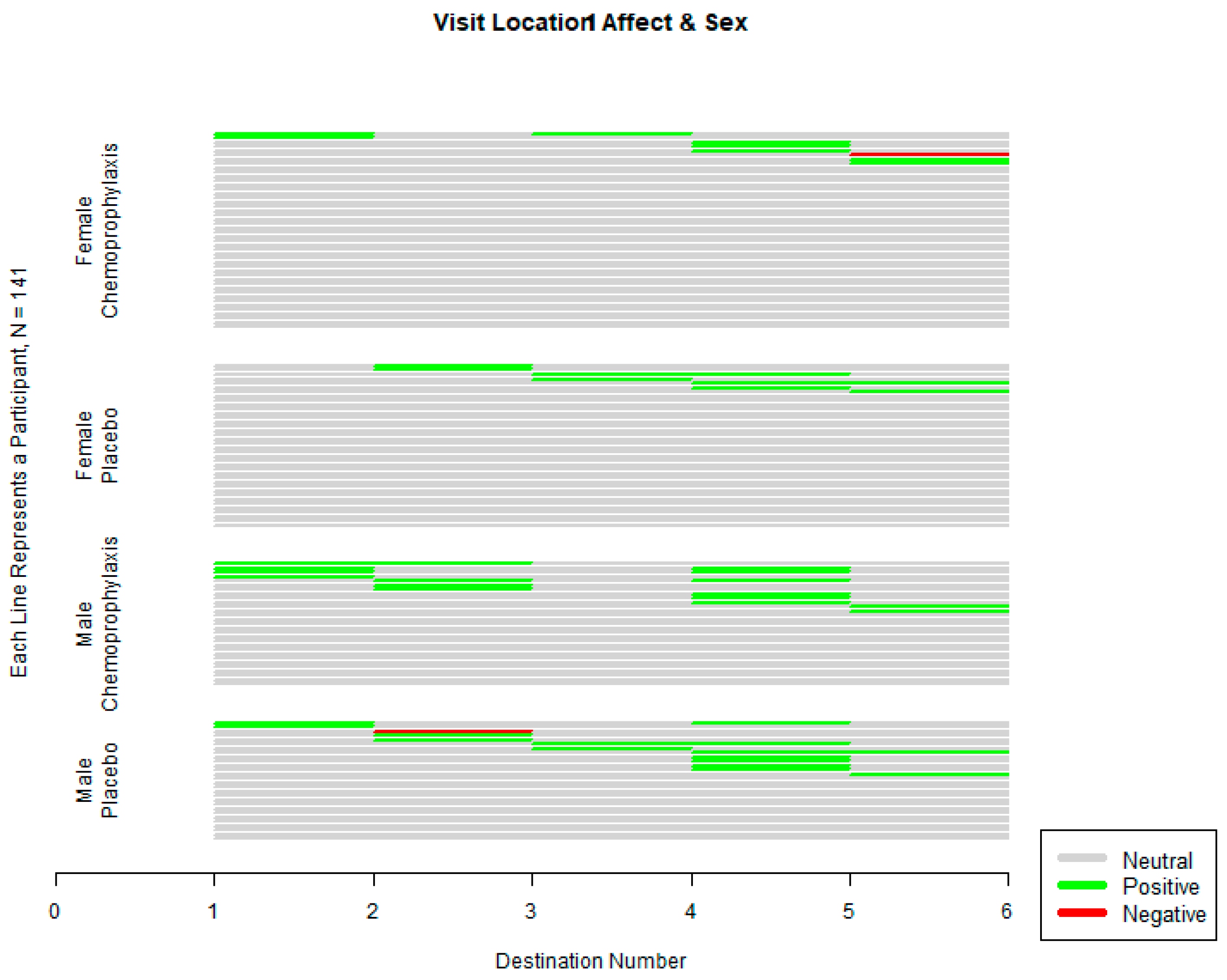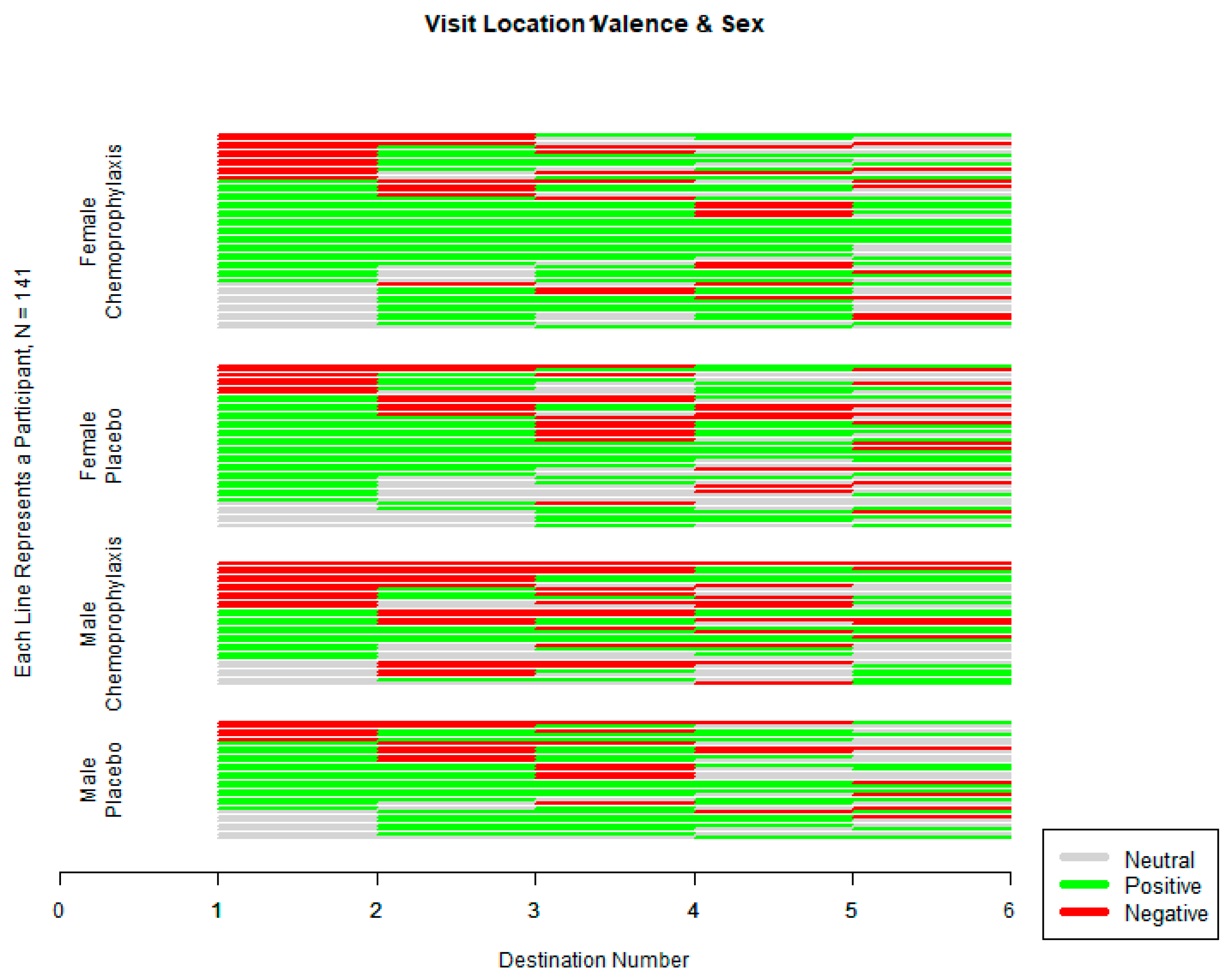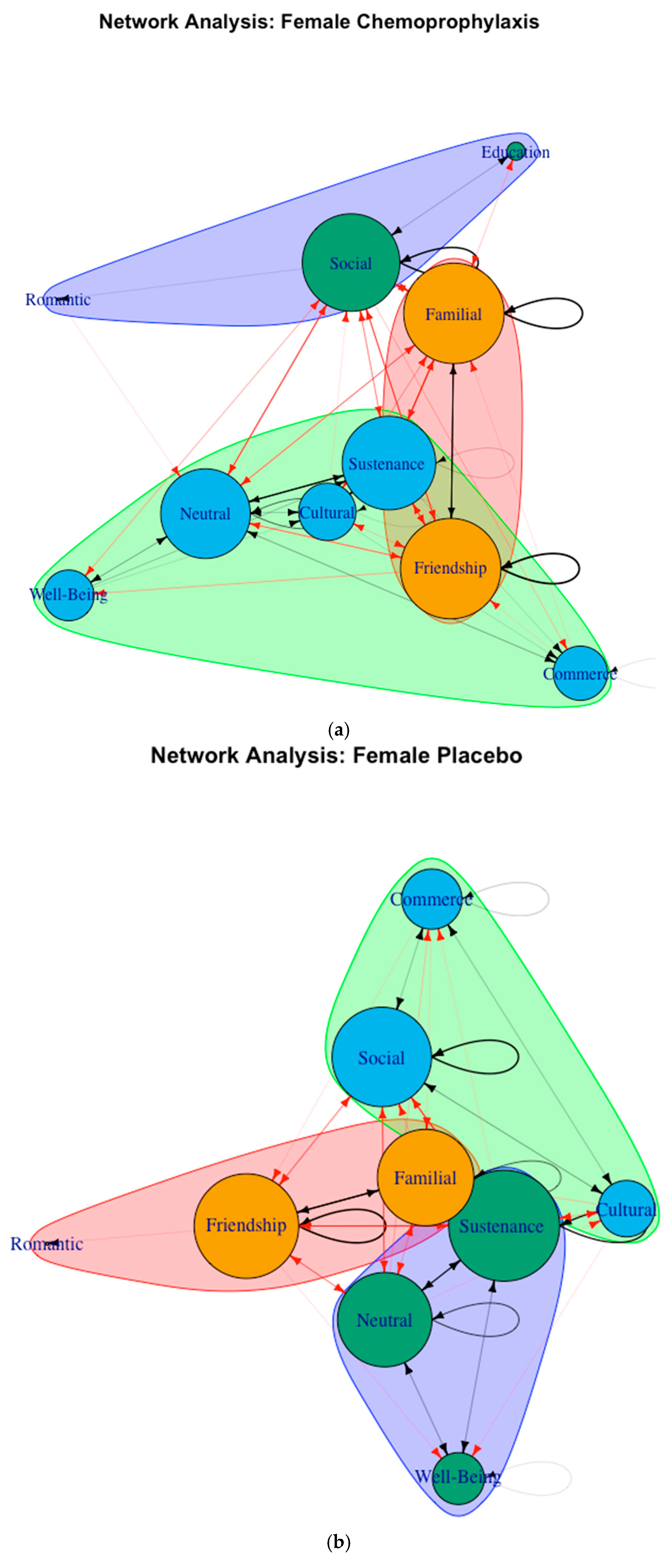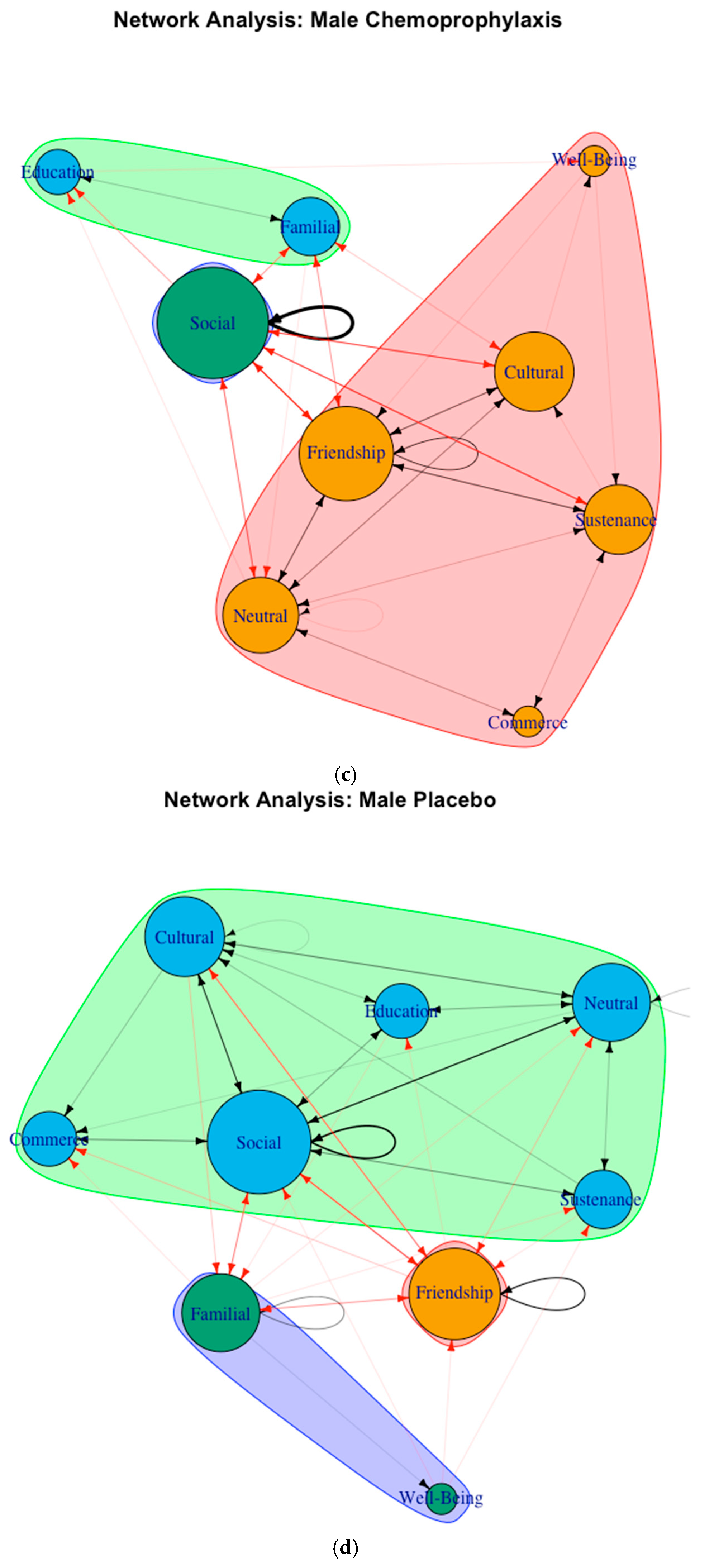Examining the Long-Term Impact of Malaria Chemoprophylaxis in Everyday Life in Rural Gambian Adolescents
Abstract
1. Introduction
1.1. Gambian Culture and Norms
1.2. Gender Dynamics
1.3. Previous Research in Rural Gambia
1.4. Study Rationale
2. Methods
2.1. Theoretical Framework
Social–Ecological Model
2.2. Touring Method
2.3. Participants
2.4. Village Walking Interview
2.5. Coding Process and Reliability
2.6. Coder Training Protocol
2.7. Emotional Content Coding
2.8. Thematic Coding
2.9. Disagreement Resolution Protocol
2.10. Reliability
2.11. Analytic Approach
3. Results
3.1. Emotional Response
3.2. Emotional Analysis
3.3. Network Analysis
4. Discussion
4.1. Social Network Structures
4.2. Limitations
5. Conclusions
Supplementary Materials
Author Contributions
Funding
Institutional Review Board Statement
Informed Consent Statement
Data Availability Statement
Acknowledgments
Conflicts of Interest
Correction Statement
References
- World Health Organization. World Malaria Report 2024: Addressing Inequity in the Global Malaria Response. 2024. Available online: https://www.who.int/teams/global-malaria-programme/reports/world-malaria-report-2024 (accessed on 12 March 2024).
- Carpenter, L.M. Gender, race, class, and sexuality in subcultural identity projects. Sex Roles 2009, 60, 432–434. [Google Scholar] [CrossRef]
- Ewbank, D.C. Impact of Health Programmes on Child Mortality in Africa: Evidence from Zaire and Liberia. Int. J. Epidemiol. 1993, 22 (Suppl. S1), S64–S72. [Google Scholar] [CrossRef]
- Fontanet, A.L.; Houzé, S.; Keundjian, A.; Schiemann, R.; Ralaimazava, P.; Durand, R.; Cha, O.; Coulaud, J.P.; Le Bras, J.; Bouchaud, O. Efficacy of antimalarial chemoprophylaxis among French residents travelling to Africa. Trans. R. Soc. Trop. Med. Hyg. 2005, 99, 91–100. [Google Scholar] [CrossRef]
- Vliegenthart-Jongbloed, K.; De Mendonça Melo, M.; Van Wolfswinkel, M.E.; Koelewijn, R.; Van Hellemond, J.J.; Van Genderen, P.J. Severity of imported malaria: Protective effect of taking malaria chemoprophylaxis. Malar. J. 2013, 12, 265. [Google Scholar] [CrossRef]
- World Health Organization. World Malaria Report 2019; World Health Organization: Geneva, Switzerland, 2019. Available online: https://iris.who.int/handle/10665/330011 (accessed on 20 August 2025).
- O’Neil, J.M. My personal gender role journey with the Gender Role Conflict Research Program. In Men’s Gender Role Conflict: Psychological Costs, Consequences, and an Agenda for Change; American Psychological Association: Worcester, MA, USA, 2015; pp. 29–38. Available online: https://www.jstor.org/stable/j.ctv1chrv60 (accessed on 4 May 2025).
- Angrist, N.; Jukes, M.C.H.; Clarke, S.; Chico, R.M.; Opondo, C.; Bundy, D.; Cohee, L.M. School-based malaria chemoprevention as a cost-effective approach to improve cognitive and educational outcomes: A meta-analysis. arXiv 2023, arXiv:2303.10684. Available online: https://arxiv.org/abs/2303.10684 (accessed on 20 August 2025).
- Clarke, S.E.; Rouhani, S.; Diarra, S.; Saye, R.; Bamadio, M.; Jones, R.; Traore, D.; Traore, K.; Jukes, M.C.; Thuilliez, J.; et al. Impact of a malaria intervention package in schools on Plasmodium infection, anaemia and cognitive function in schoolchildren in Mali: A pragmatic cluster-randomised trial. BMJ Glob. Health 2017, 2, e000182. [Google Scholar] [CrossRef]
- Lalloo, D.G.; Olukoya, P.; Olliaro, P. Malaria in adolescence: Burden of disease, consequences, and opportunities for intervention. Lancet Infect. Dis. 2006, 6, 780–793. [Google Scholar] [CrossRef] [PubMed]
- Worldometer. Gambia Demographics. Available online: https://www.worldometers.info/demographics/gambia-demographics/ (accessed on 13 November 2024).
- World Health Organization. World Malaria Report 2023, 1st ed.; World Health Organization: Geneva, Switzerland, 2023; 1p.
- Mwakikagile, G. The Gambia and Its People: Ethnic Identities and Cultural Integration in Africa, 1st ed.; New Africa Press: Dar es Salaam, Tanzania, 2010. [Google Scholar]
- Kea, P. ‘The complexity of an enduring relationship’: Gender, generation, and the moral economy of the G ambian M andinka household. J. R. Anthropol. Inst. 2013, 19, 102–119. [Google Scholar] [CrossRef]
- Steegstra, M. Krobo Queen Mothers: Gender, Power and Contemporary Female Traditional Authority in Ghana. Afr. Today 2009, 55, 104–123. [Google Scholar] [CrossRef]
- Carney, J. Development: Critical Essays in Human Geography; Contemporary Foundations of Space and Place; Corbridge, S., Ed.; Routledge: London, UK, 2016; 1p. [Google Scholar]
- Jassey, K. In the eyes of the beholder: Male and female agency in relation to ‘race’, sexuality, love and money. In Workshop on Sex and Gender in Africa: Critical and Feminist Approaches During Nordic Africa Days; Nordic Africa Institute: Uppsala, Sweden, 2005. [Google Scholar]
- Madge, C. Ethnography and agroforestry research: A case study from the Gambia. Agroforest Syst. 1995, 32, 127–146. [Google Scholar] [CrossRef]
- Saine, A. Culture and Customs of Gambia; Culture and customs of Africa; Greenwood: Santa Barbara, CA, USA, 2012. [Google Scholar]
- Thomson, R.; Bell, R.; Holland, J.; Henderson, S.; McGrellis, S.; Sharpe, S. Critical Moments: Choice, Chance and Opportunity in Young People’s Narratives of Transition. Sociology 2002, 36, 335–354. [Google Scholar] [CrossRef]
- Sarr, A. Gender, Spirituality, and Economic Change in Rural Gambia: Agricultural Production in the Lower Gambia Region, c. 1830s–1940s. Afr. Econ. Hist. 2017, 45, 1–26. [Google Scholar] [CrossRef]
- Greenwood, B. Comparison of two strategies for control of malaria within a primary health care programme in the gambia. Lancet 1988, 331, 1121–1127. [Google Scholar] [CrossRef] [PubMed]
- Jukes, M.C.H.; Pinder, M.; Grigorenko, E.L.; Smith, H.B.; Walraven, G.; Bariau, E.M.; Sternberg, R.J.; Drake, L.J.; Milligan, P.; Cheung, Y.B.; et al. Long-Term Impact of Malaria Chemoprophylaxis on Cognitive Abilities and Educational Attainment: Follow-Up of a Controlled Trial. PLOS Clin. Trials 2006, 1, e19. [Google Scholar] [CrossRef]
- Amaya, V.; Chardon, M.; Klein, H.; Moulaert, T.; Vuillerme, N. What Do We Know about the Use of the Walk-along Method to Identify the Perceived Neighborhood Environment Correlates of Walking Activity in Healthy Older Adults: Methodological Considerations Related to Data Collection—A Systematic Review. Sustainability 2022, 14, 11792. [Google Scholar] [CrossRef]
- Amaya, V.; Chardon, M.; Moulaert, T.; Vuillerme, N. Systematic Review of the Use of the Walk-Along Interview Method to Assess Factors, Facilitators and Barriers Related to Perceived Neighborhood Environment and Walking Activity in Healthy Older Adults. Sustainability 2024, 16, 882. [Google Scholar] [CrossRef]
- Carney, J.; Watts, M. Disciplining Women? Rice, Mechanization, and the Evolution of Mandinka Gender Relations in Senegambia. Signs J. Women Cult. Soc. 1991, 16, 651–681. [Google Scholar] [CrossRef]
- Schroeder, R.A. Shady Practices: Agroforestry and Gender Politics in the Gambia; California Studies in Critical Human Geography; University of California Press: Berkeley, CA, USA, 1999; 1p. [Google Scholar]
- Zhang, D.; Ling, G.H.T.; Misnan, S.H.B.; Fang, M. A Systematic Review of Factors Influencing the Vitality of Public Open Spaces: A Novel Perspective Using Social–Ecological Model (SEM). Sustainability 2023, 15, 5235. [Google Scholar] [CrossRef]
- Carpiano, R.M. Come take a walk with me: The “Go-Along” interview as a novel method for studying the implications of place for health and well-being. Health Place 2009, 15, 263–272. [Google Scholar] [CrossRef]
- Evans, J.; Jones, P. The walking interview: Methodology, mobility and place. Appl. Geogr. 2011, 31, 849–858. [Google Scholar] [CrossRef]
- Lowe, M.; Chen, D.R.; Huang, S.L. Social and Cultural Factors Affecting Maternal Health in Rural Gambia: An Exploratory Qualitative Study. PLoS ONE 2016, 11, e0163653. [Google Scholar] [CrossRef] [PubMed]
- Lőrinc, M.; Kilkey, M.; Ryan, L.; Tawodzera, O. “You Still Want to Go Lots of Places”: Exploring Walking Interviews in Research With Older Migrants. Gerontologist 2022, 62, 832–841. [Google Scholar] [CrossRef]
- Klicnik, I.; Riad Andrawes, R.; Bell, L.; Manafo, J.; Meens Miller, E.; Sun, W.; Widener, M.; Dogra, S. Insights from neighbourhood walking interviews using the Living Environments and Active Aging Framework (LEAAF) in community-dwelling older adults. Health Place 2024, 89, 103339. [Google Scholar] [CrossRef]
- Bilsland, K.; Siebert, S. Walking interviews in organizational research. Eur. Manag. J. 2024, 42, 161–172. [Google Scholar] [CrossRef]
- Kinney, P. Walking Interviews. 2017. Available online: https://sru.soc.surrey.ac.uk/SRU67.pdf (accessed on 20 April 2025).
- Bronfenbrenner, U. The Ecology of Human Development: Experiments by Nature and Design; Harvard University Press: Cambridge, CA, USA, 1981; Available online: http://www.jstor.org/stable/10.2307/j.ctv26071r6 (accessed on 20 August 2025).
- Bale, T.L.; Epperson, C.N. Sex differences and stress across the lifespan. Nat. Neurosci. 2015, 18, 1413–1420. [Google Scholar] [CrossRef]
- Gabard-Durnam, L.J.; McLaughlin, K.A. Do Sensitive Periods Exist for Exposure to Adversity? Biol. Psychiatry 2019, 85, 789–791. [Google Scholar] [CrossRef]
- Werling, D.M.; Geschwind, D.H. Sex differences in autism spectrum disorders. Curr. Opin. Neurol. 2013, 26, 146–153. [Google Scholar] [CrossRef]
- Keenan, K.; Shaw, D. Developmental and social influences on young girls’ early problem behavior. Psychol. Bull. 1997, 121, 95–113. [Google Scholar] [CrossRef]
- Rose, A.J.; Rudolph, K.D. A review of sex differences in peer relationship processes: Potential trade-offs for the emotional and behavioral development of girls and boys. Psychol. Bull. 2006, 132, 98–131. [Google Scholar] [CrossRef] [PubMed]
- Nelson, E.E.; Leibenluft, E.; McClure, E.B.; Pine, D.S. The social re-orientation of adolescence: A neuroscience perspective on the process and its relation to psychopathology. Psychol. Med. 2005, 35, 163–174. [Google Scholar] [CrossRef] [PubMed]
- Elder, J.P.; Lytle, L.; Sallis, J.F.; Young, D.R.; Steckler, A.; Simons-Morton, D.; Stone, E.; Jobe, J.B.; Stevens, J.; Lohman, T.; et al. A description of the social-ecological framework used in the trial of activity for adolescent girls (TAAG). Health Educ. Res. 2006, 22, 155–165. [Google Scholar] [CrossRef] [PubMed]
- Blakemore, S.J. The social brain in adolescence. Nat. Rev. Neurosci. 2008, 9, 267–277. [Google Scholar] [CrossRef] [PubMed]
- Henrich, J.; McElreath, R. The evolution of cultural evolution. Evol. Anthropol. 2003, 12, 123–135. [Google Scholar] [CrossRef]




| Theme | Definition |
|---|---|
| Friendship | If the participants’ statements had any mention of a friend or any activities that involved friends and not the whole community |
| Cultural | If the participant mentioned religion or traditional ceremonies and rituals, or when spiritual views are expressed. |
| Romantic | If the participant mentions anything about any romantic interest, such as going to a location to meet a partner and starting a family. |
| Sustenance | If the participant mentioned activities important to sustenance, such as fetching water or food to cook. |
| Education | If they mentioned anything about education, such as schooling or gaining expertise training. |
| Social | This category is different from the friendship category as this encompasses more of the community instead of only friends. Cultural and community events such as drinking attaya (i.e., tea-sharing community). |
| Commerce | If the participant mentions anything about professions, trade, or any monetary exchange |
| Familial | Anything that involves a family member (regardless of the distance in relation) or even if a friend is mentioned along with a family member. |
| Well-Being | If a participant mentioned anything about personal health or well-being or wanted to do an activity just to relax and have fun. |
| Neutral | If no statement was given or they did not mention any of the previous categories. |
| Network | Nodes | Edges | Density | Avg. Total Degree | Avg. Weighted Degree | Reciprocity | Transitivity (Global) |
|---|---|---|---|---|---|---|---|
| Male Chemoprophylaxis | 9 | 41 | 0.57 | 9.11 | 25.78 | 0.79 | 0.66 |
| Male Placebo | 9 | 48 | 0.67 | 10.67 | 24.89 | 0.65 | 0.83 |
| Female Chemoprophylaxis | 10 | 56 | 0.62 | 11.20 | 36.80 | 0.78 | 0.81 |
| Female Placebo | 9 | 47 | 0.65 | 10.44 | 33.78 | 0.75 | 0.81 |
Disclaimer/Publisher’s Note: The statements, opinions and data contained in all publications are solely those of the individual author(s) and contributor(s) and not of MDPI and/or the editor(s). MDPI and/or the editor(s) disclaim responsibility for any injury to people or property resulting from any ideas, methods, instructions or products referred to in the content. |
© 2025 by the authors. Licensee MDPI, Basel, Switzerland. This article is an open access article distributed under the terms and conditions of the Creative Commons Attribution (CC BY) license (https://creativecommons.org/licenses/by/4.0/).
Share and Cite
Miller, B.; Hoang, A.; Litwin, G.; Jukes, M.C.H.; Kilani, H.; Grigorenko, E.L. Examining the Long-Term Impact of Malaria Chemoprophylaxis in Everyday Life in Rural Gambian Adolescents. Adolescents 2025, 5, 46. https://doi.org/10.3390/adolescents5030046
Miller B, Hoang A, Litwin G, Jukes MCH, Kilani H, Grigorenko EL. Examining the Long-Term Impact of Malaria Chemoprophylaxis in Everyday Life in Rural Gambian Adolescents. Adolescents. 2025; 5(3):46. https://doi.org/10.3390/adolescents5030046
Chicago/Turabian StyleMiller, Brittany, Andy Hoang, Griffin Litwin, Matthew C. H. Jukes, Hechmi Kilani, and Elena L. Grigorenko. 2025. "Examining the Long-Term Impact of Malaria Chemoprophylaxis in Everyday Life in Rural Gambian Adolescents" Adolescents 5, no. 3: 46. https://doi.org/10.3390/adolescents5030046
APA StyleMiller, B., Hoang, A., Litwin, G., Jukes, M. C. H., Kilani, H., & Grigorenko, E. L. (2025). Examining the Long-Term Impact of Malaria Chemoprophylaxis in Everyday Life in Rural Gambian Adolescents. Adolescents, 5(3), 46. https://doi.org/10.3390/adolescents5030046






